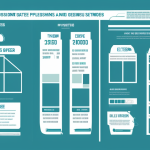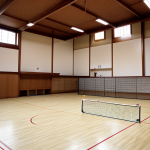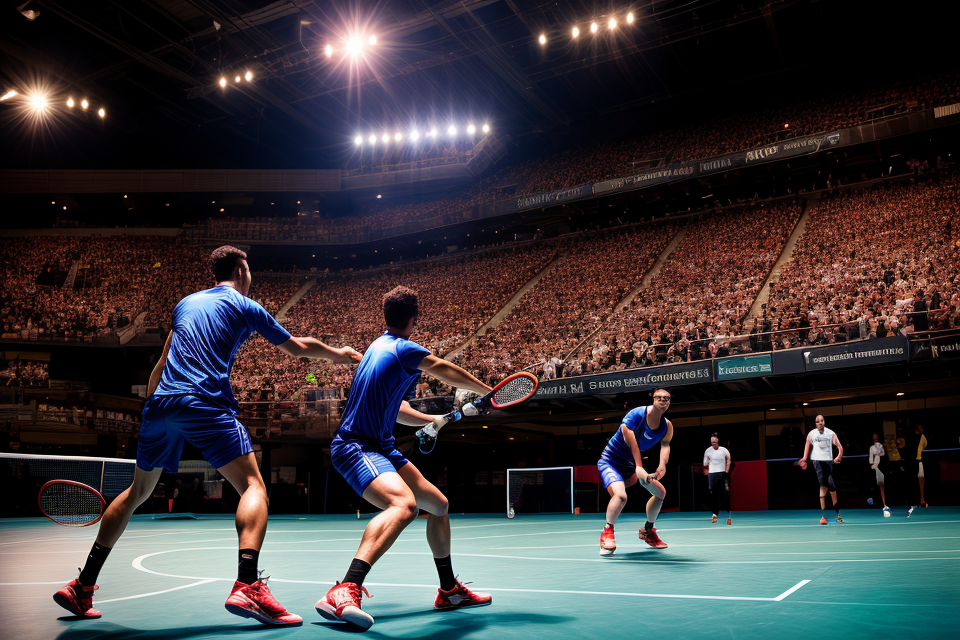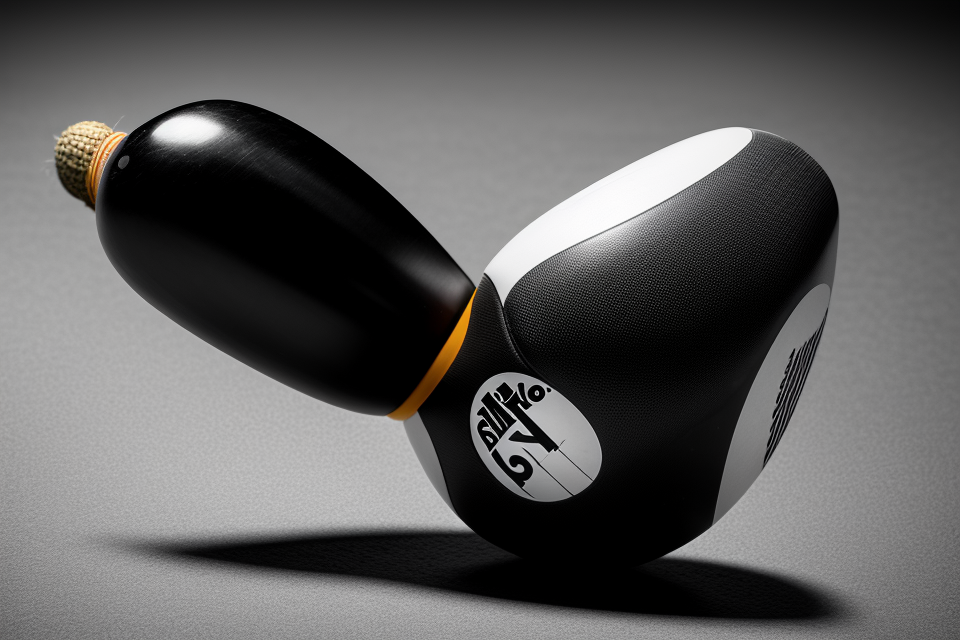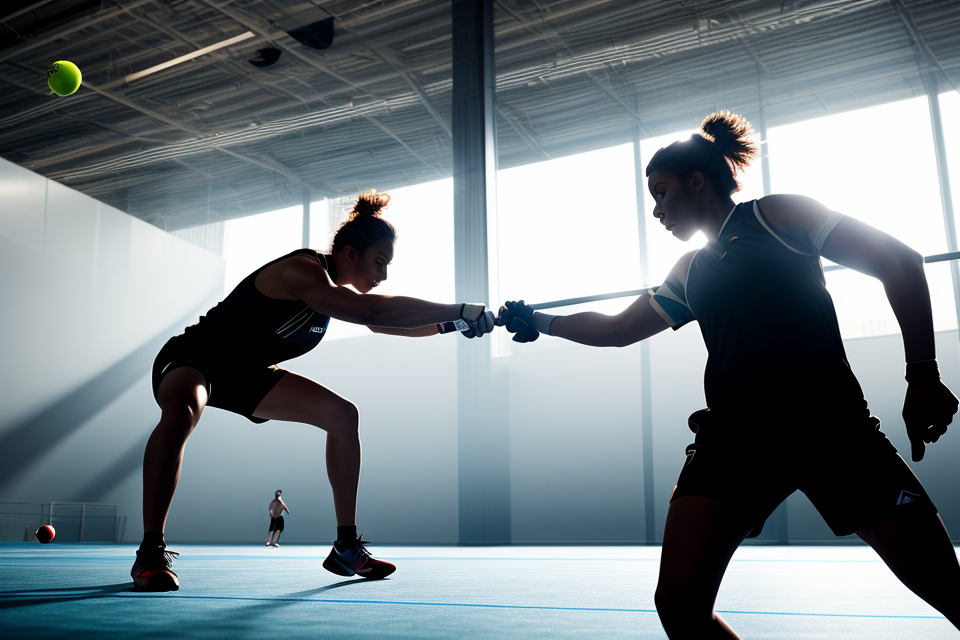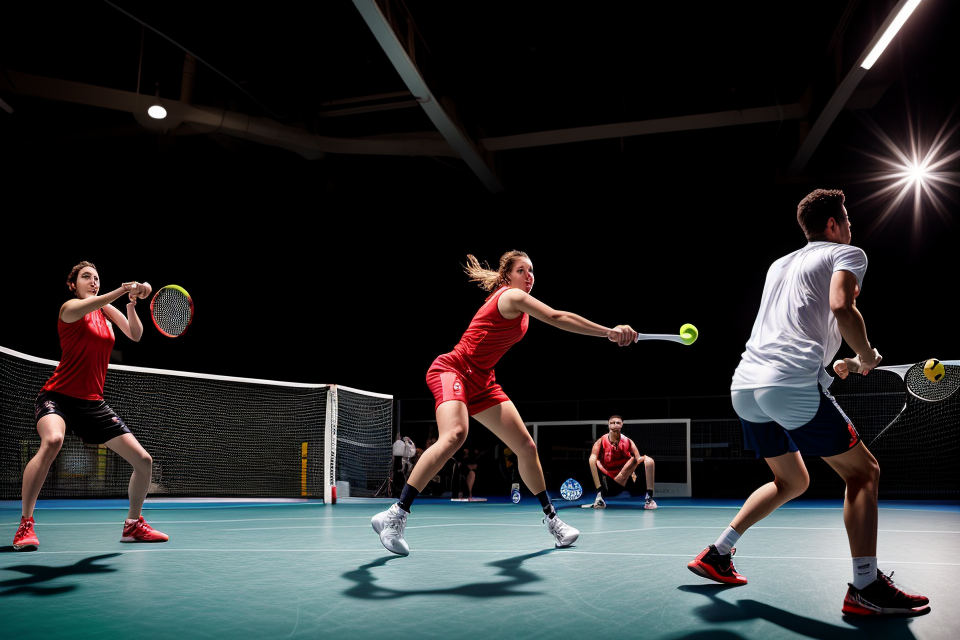Squash is a game that requires a combination of physical fitness, mental agility, and strategic thinking. While it can be frustrating to lose to a better player, there are ways to improve your game and increase your chances of beating them. In this article, we will explore some strategies and techniques that can help you level up your squash game and take on tougher opponents. Whether you’re a beginner or an experienced player, these tips will give you the edge you need to improve your performance on the court. So, gear up and get ready to take your squash game to the next level!
Understanding Your Opponent
Observing the Opponent’s Playstyle
When facing a better opponent in squash, it is crucial to understand their playstyle. This involves observing their body language, shots played, and tactics used during the game. Here are some key points to consider:
- Body language: Pay attention to your opponent’s body language, such as their facial expressions, posture, and movements. This can provide insight into their confidence level, physical condition, and potential weaknesses. For example, if your opponent is consistently showing signs of fatigue, it may indicate that they are more likely to make mistakes towards the end of the game.
- Shots played: Take note of the shots your opponent plays, including their strengths and weaknesses. This can help you anticipate their next move and develop a strategy to counter their play. For instance, if your opponent tends to hit a lot of cross-court shots, you may want to focus on hitting more shots down the wall to force them to play more straight shots.
- Tactics used: Observe the tactics your opponent uses during the game, such as their serves, returns, and volleys. This can help you understand their overall strategy and identify any patterns or tendencies. For example, if your opponent often serves to your backhand side, you may want to work on improving your backhand to handle those shots better.
By carefully observing your opponent’s playstyle, you can gain valuable insights that can help you develop a winning strategy. Remember to stay focused on the game and avoid getting too caught up in analyzing your opponent’s moves, as this can take away from your own performance.
Adapting to Your Opponent’s Playstyle
One of the key strategies for improving your squash game and beating better players is to adapt to your opponent’s playstyle. This means understanding their strengths and weaknesses, and adjusting your own game accordingly. Here are some specific ways to do this:
Change your own playstyle
The first step in adapting to your opponent’s playstyle is to be willing to change your own playstyle. This means being flexible and open to trying new techniques and strategies, even if they are outside of your comfort zone. By changing your own playstyle, you can make it more difficult for your opponent to predict your moves and gain an advantage.
Exploit weaknesses
Another way to adapt to your opponent’s playstyle is to exploit their weaknesses. This means identifying areas where they are not as strong, and using those areas to your advantage. For example, if your opponent is weak at volleying, you can focus on hitting volleys to their weaker side. By exploiting their weaknesses, you can gain an advantage and potentially win the point.
Counter their tactics
Finally, it’s important to counter your opponent’s tactics. This means anticipating what they are likely to do, and having a plan in place to counter it. For example, if your opponent is a good dropper, you can focus on being in the right position to hit a successful drive or boast. By countering their tactics, you can disrupt their game and gain an advantage.
Overall, adapting to your opponent’s playstyle is a crucial strategy for improving your squash game and beating better players. By changing your own playstyle, exploiting their weaknesses, and countering their tactics, you can gain an advantage and potentially win the match.
Improving Your Skills
Physical Fitness
- Footwork
- Develop your footwork by practicing movement drills such as ladder drills, shuffle drills, and cone drills.
- Focus on moving quickly and efficiently in all directions, including forwards, backwards, and sideways.
- Work on your balance and coordination by practicing on a single leg or by standing on a balance board.
- Agility
- Improve your agility by practicing quick movements and reactions.
- Incorporate exercises such as plyometrics, jumps, and agility ladder drills into your training routine.
- Play games or sports that require quick movements and reaction times, such as soccer or basketball, to improve your agility.
- Stamina
- Increase your stamina by incorporating cardiovascular exercises into your training routine, such as running, cycling, or swimming.
- Aim to increase your endurance by gradually increasing the duration and intensity of your workouts.
- Incorporate strength training exercises, such as squats and lunges, to build muscular endurance and improve your overall fitness level.
Technical Skills
To improve your squash game and beat better players, you need to focus on developing your technical skills. Here are some key areas to work on:
- Strokes: The quality of your strokes will have a direct impact on your performance on the court. It’s important to master the basic strokes such as the forehand, backhand, and volley. Work on developing a smooth and consistent stroke technique, and aim to hit the ball with power and accuracy.
- Positions: In squash, positioning is key. You need to be able to move around the court quickly and efficiently, and position yourself in the right place to hit the ball. Practice your footwork and aim to improve your agility and speed.
- Shots: There are a variety of shots you can use in squash, including drops, drives, and boasts. It’s important to be able to hit a range of shots and to use them effectively in different situations. Practice your shot selection and aim to develop a solid repertoire of shots that you can use in matches.
Overall, improving your technical skills requires dedication and practice. Work on developing your strokes, positions, and shots, and aim to become a more well-rounded player. With time and effort, you’ll be able to take your squash game to the next level and beat better players.
Mental Game
Having a strong mental game is crucial to improving your squash game and beating better players. Here are some strategies to help you develop a winning mindset:
Focus
Focus is a critical aspect of the mental game. To improve your focus, try the following:
- Set specific goals for each game or match
- Practice visualization techniques, such as imagining yourself making successful shots
- Stay present during the game and avoid distractions
- Use positive self-talk to maintain motivation and confidence
Confidence
Confidence is key to performing at your best on the squash court. To build your confidence, try the following:
- Practice regularly and set realistic goals for yourself
- Celebrate your successes, no matter how small they may be
- Surround yourself with supportive people who believe in your abilities
- Learn from your mistakes and use them as opportunities for growth
Strategy
Having a solid strategy is essential to outsmarting better players. To develop a winning strategy, try the following:
- Analyze your strengths and weaknesses and develop a plan to exploit your opponent’s weaknesses
- Watch and learn from professional players to get a sense of their strategies and tactics
- Practice different game scenarios to prepare for various situations on the court
- Stay flexible and adapt your strategy as needed during the game or match.
Tactics and Strategies
Ball Control
- Placement
- One of the most crucial aspects of ball control in squash is the ability to place the ball accurately and effectively. This involves hitting the ball in such a way that it bounces in a specific location on the court, either to set up an attack or to simply keep the rally going.
- To improve your ball placement, focus on hitting the ball with precision and control, aiming for the corners of the court or for the front wall. Pay attention to the angle of your shot and try to hit the ball in a way that will make it difficult for your opponent to return.
- Speed
- Another important aspect of ball control is the ability to vary the speed of your shots. This can help you to keep your opponent off balance and to create openings for your own attacks.
- To improve your speed control, practice hitting the ball at different speeds, both hard and soft. Pay attention to the pace of the rally and try to adjust your shot speed accordingly.
- Spin
- Using spin on your shots can be a powerful weapon in squash, as it can make the ball difficult to return and can also create openings for your own attacks.
- To improve your spin control, practice hitting the ball with top spin, backspin, and slice. Experiment with different types of spins and pay attention to the result of each shot. Practice hitting the ball with spin in different situations, such as when your opponent is at the front or back of the court.
Court Coverage
- Movement
- Positioning
Movement
To improve your squash game and beat better players, it is essential to focus on movement. Movement in squash is critical because it allows you to get into position to hit your shots and to get out of the way of your opponent’s shots. To improve your movement, practice your footwork drills and try to stay low on your toes. This will help you to move quickly and efficiently around the court.
Positioning
Another key aspect of court coverage is positioning. This means being in the right place on the court to hit your shots and to defend against your opponent’s shots. To improve your positioning, practice your shot selection and try to anticipate where your opponent is going to hit the ball. This will help you to get into position to hit your shots and to defend against your opponent’s shots.
Placement
Finally, placement is also an important aspect of court coverage. This means hitting your shots to the right places on the court to put pressure on your opponent and to set up points. To improve your placement, practice your shot selection and try to hit your shots to the corners of the court. This will help you to put pressure on your opponent and to set up points.
By focusing on movement, positioning, and placement, you can improve your squash game and beat better players. Remember to practice these skills regularly and to use them in your matches to achieve success on the court.
Attacking Strategies
When it comes to attacking strategies in squash, there are three key techniques that players should master: serve, volley, and drive. Each of these techniques requires a different approach and should be used in different situations on the court.
Serve
The serve is the first point of the game and is an essential part of a player’s attacking strategy. A good serve should be fast and accurate, aiming to catch the opponent off guard and set up a strong follow-up shot. Some tips for a successful serve include:
- Standing in the right position: The server should stand behind the right-hand service line and aim to hit the ball diagonally across the court.
- Using the right grip: A firm grip on the racket is essential for a powerful serve.
- Focusing on footwork: The server should take a big step forward with their left foot and swing the racket from the right side of their body.
Volley
The volley is a shot that is hit before the opponent has a chance to return the serve. It is often used as a surprise attack and can catch the opponent off guard. Some tips for a successful volley include:
- Standing in the right position: The player should stand near the front of the court and angle their body slightly to the left.
- Using the right grip: A neutral grip on the racket is ideal for a volley.
- Focusing on footwork: The player should take a small step forward with their left foot and swing the racket from the left side of their body.
Drive
The drive is a shot that is hit after the opponent has returned the serve. It is often used as an attacking shot and can be hit with power and accuracy. Some tips for a successful drive include:
- Standing in the right position: The player should stand near the back of the court and angle their body slightly to the right.
- Using the right grip: A firm grip on the racket is essential for a powerful drive.
- Focusing on footwork: The player should take a small step forward with their right foot and swing the racket from the right side of their body.
In conclusion, mastering these attacking strategies is essential for any squash player looking to improve their game and beat better players. Whether it’s a powerful serve, a surprise volley, or a well-placed drive, these techniques can help players gain an advantage on the court and take their game to the next level.
Defensive Strategies
The key to improving your squash game is to understand and master the art of defensive strategies. By learning how to use the drop shot, boast, and lob effectively, you can set yourself up to outsmart and outmaneuver better players.
Drop Shot
The drop shot is a crucial defensive strategy in squash, as it allows you to control the pace of the game and force your opponent off the wall. To execute a drop shot successfully, you need to:
- Stand about 10-15 feet from the front wall, depending on your opponent’s strength and style.
- Drop the racquet head, keeping it low to the ground.
- Swing the racquet upward and hit the ball with a scooping motion, sending it high into the air towards the front wall.
- Move forward to the T or O position as the ball bounces on the floor.
By mastering the drop shot, you can keep your opponent guessing and give yourself more time to prepare for their next shot.
Boast
The boast is another essential defensive strategy that involves hitting the ball hard off the back wall after your opponent has hit a shot. To execute a successful boast, follow these steps:
- Stand near the side wall, ready to respond to your opponent’s shot.
- Take a few steps forward to meet the ball.
- Hit the ball with a hard, flat stroke, sending it high into the air towards the front wall.
Boasting effectively can help you gain control of the rally and force your opponent into making mistakes.
Lob
The lob is a tactic used to push your opponent back and gain court position. To execute a successful lob, follow these steps:
- Stand near the back of the court, away from the wall.
- Wait for your opponent to hit a shot that bounces high on the wall.
- Move forward slightly to meet the ball.
- Hit the ball with a soft, controlled stroke, sending it high into the air towards the back wall.
- Move forward to the T or O position as the ball bounces on the floor.
By mastering the lob, you can force your opponent to cover more ground and make it difficult for them to hit winners.
In conclusion, mastering defensive strategies like the drop shot, boast, and lob can significantly improve your squash game and help you beat better players. Practice these techniques regularly and incorporate them into your game to gain a competitive edge on the court.
Equipment and Accessories
Squash Racket
Selecting the right squash racket is crucial to improving your game. Here are some factors to consider when choosing a squash racket:
Grip
The grip of a squash racket is an essential component that affects your control and precision during the game. A comfortable grip is crucial, as it enables you to maintain a firm hold on the racket during intense rallies.
String
The string tension of a squash racket significantly impacts the performance of the racket. A higher string tension provides more power and control, while a lower string tension offers more flexibility and spin. Choose a string tension that suits your playing style and preferences.
Weight
The weight of a squash racket is another important factor to consider. A heavier racket offers more power and stability, while a lighter racket provides greater maneuverability and speed. Choose a racket weight that complements your playing style and physical abilities.
Additionally, consider the balance and flexibility of the racket. A well-balanced racket offers better control and stability, while a flexible racket provides more power and spin. Experiment with different racket designs and materials to find the one that best suits your playing style.
Remember, the right squash racket can enhance your performance and improve your game. It is essential to choose a racket that fits your playing style, preferences, and physical abilities. Investing in a high-quality squash racket can make a significant difference in your game and help you beat better players.
Eyewear
Proper eyewear is crucial for squash players as it protects the eyes from injury and helps in enhancing vision during the game. Here are some of the key features to look for when choosing eyewear for squash:
Tinted Lenses
Tinted lenses are a popular choice among squash players as they help in reducing glare and enhance contrast, which makes it easier to see the ball and the court. Grey, brown, and amber are some of the popular tints used in squash eyewear.
UV Protection
Squash courts are often poorly ventilated, and this can make players vulnerable to UV radiation. Therefore, it is essential to choose eyewear that offers UV protection. Look for eyewear with a UV rating of 400 or higher, which indicates that the lenses block out 99% of UV rays.
Anti-fog Coating
Sweat and humidity can cause the lenses to fog up, which can be a significant distraction during the game. Eyewear with an anti-fog coating helps in preventing this problem, allowing players to maintain a clear view of the court at all times.
In addition to these features, it is also important to choose eyewear that fits comfortably and provides adequate coverage for the eyes. The frame should be lightweight and durable, with a snug fit that prevents it from slipping during play.
When selecting eyewear for squash, it is recommended to try out different options to find the right fit and style that suits your needs.
Footwear
- Lightweight: Squash shoes should be lightweight to allow for quick movements on the court.
- Non-marking soles: Non-marking soles prevent scuff marks on the court and also provide better traction.
- Supportive: The shoes should have a sturdy and supportive sole that can withstand the impact of running and jumping on the court. Additionally, a good squash shoe should have a stable fit around the ankle to prevent rollover injuries.
FAQs
1. What are some effective strategies for beating a better squash player?
One effective strategy for beating a better squash player is to focus on improving your fitness level and conditioning. Squash is a physically demanding sport that requires a high level of endurance, strength, and agility. By working on your fitness, you can improve your stamina and endurance, allowing you to keep up with better players and maintain your performance throughout the game.
Another important strategy is to work on your technical skills and shot selection. Better players typically have a more diverse and sophisticated arsenal of shots, so it’s important to study their game and learn their techniques. You can also work with a coach or attend clinics to improve your technique and develop your own unique shot selection.
Finally, it’s important to develop a strong mental game. Squash is a mental as well as a physical sport, and the better players are often those who are able to stay focused and maintain their composure under pressure. Work on your mental toughness by visualizing success, managing your emotions, and staying positive even when things aren’t going your way.
2. How can I improve my shot selection?
Improving your shot selection is key to beating better squash players. One way to do this is to study the game of top players and pay attention to the types of shots they use and how they set up their opponents. You can also work with a coach or attend clinics to learn new shots and refine your technique.
It’s important to have a variety of shots in your arsenal, including cross-court shots, lobs, and drives. Practice hitting these shots with accuracy and power, and try to mix them up to keep your opponent guessing. Additionally, focus on your footwork and positioning, as this will help you to get into position to hit the best possible shots.
3. How can I improve my fitness level for squash?
Improving your fitness level is crucial for beating better squash players. Squash is a high-intensity sport that requires a lot of running, jumping, and changing direction quickly. To improve your fitness, it’s important to incorporate exercises that target the muscles used in squash, such as your legs, core, and upper body.
Consider incorporating exercises like sprints, interval training, and plyometrics into your workout routine. Additionally, make sure to focus on your endurance by incorporating long-distance running or cycling into your routine. It’s also important to stretch and foam roll regularly to prevent injuries and improve your flexibility.
4. How can I develop a strong mental game in squash?
Developing a strong mental game is crucial for beating better squash players. Start by working on your focus and concentration, and try to stay in the moment and avoid getting distracted by external factors. Visualization can also be a powerful tool for building confidence and staying positive.
It’s also important to manage your emotions and stay calm under pressure. This can be challenging, but try to take deep breaths and stay centered when things aren’t going your way. Additionally, try to stay positive and avoid negative self-talk, as this can be detrimental to your performance.
Finally, make sure to practice good sportsmanship and maintain a positive attitude, even when you’re losing. This will help you to maintain a positive reputation on the court and build relationships with other players.


